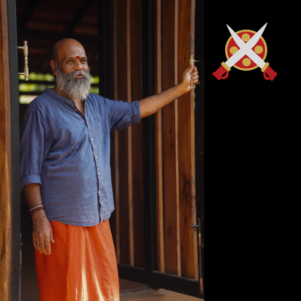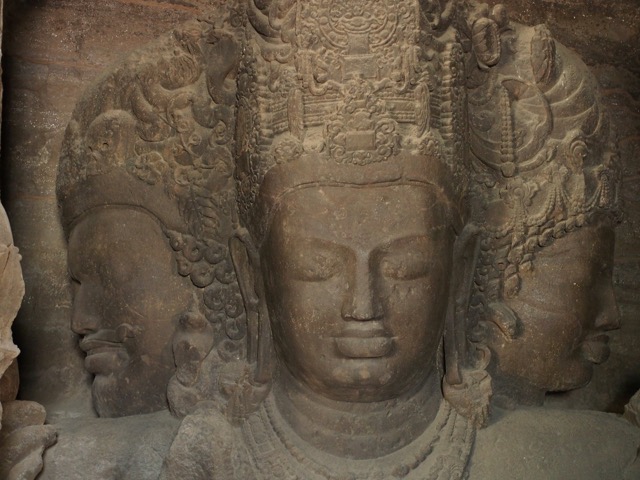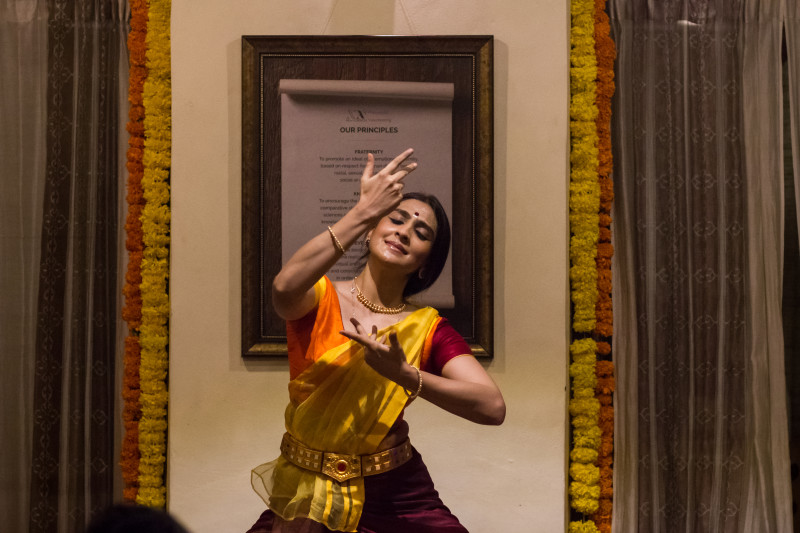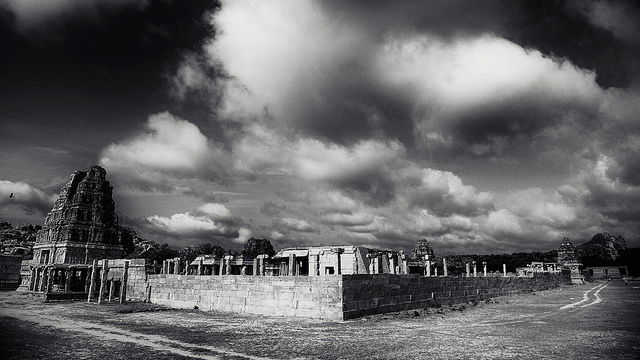The Ancient Tradition of Kalaripayattu: In conversation with Lakshmanan Gurukkal
Article By Axelle Defrasne
 Shri Lakshmanan Gurukkal hails from a traditional Kalaripayattu family. His father and guru, Shri Veerasree Sami Gurukkal who trained under Guru Govindankutty Nambiar, established the Hindustan Kalari Sangam in Calicut, in 1952, to preserve and promote this traditional martial art form. His children Shri Lakshmanan, Shri Shatrughnan and Smt Radhika are now carrying forward this tradition.
Shri Lakshmanan Gurukkal hails from a traditional Kalaripayattu family. His father and guru, Shri Veerasree Sami Gurukkal who trained under Guru Govindankutty Nambiar, established the Hindustan Kalari Sangam in Calicut, in 1952, to preserve and promote this traditional martial art form. His children Shri Lakshmanan, Shri Shatrughnan and Smt Radhika are now carrying forward this tradition.
In 2010, Shri Lakshmanan Gurukkal founded Kalarigram, near Auroville, as a traditional Kalaripayattu training center, that conducts classes and workshops in the intersecting disciplines of Kalaripayattu, Ayurveda, Yoga and Meditation. In his mission to revive Kalaripayattu, he is also the vision behind Tantrotsav, Kalarigram’s annual Temple Festival that celebrates and promotes Kalaripayattu, Tantra, Art and Culture. The festival unfolds over a span of 2 weeks and culminates on the night of the Maha Shivaratri, (the great night of Shiva, the cosmic dancer), and commemorates Lord Shiva’s execution of the Tandava, the divine dance of cosmic creation, preservation and destruction.
I have had the privilege of studying under Shri Lakshmanan’s tutelage a few weeks a year since 2018. For me, the practice of Kalari is like a detox, physically, emotionally and mentally. It extracts everything out of me, engenders values such as humility, inner-silence, empathy and each year that I go, I am able to encounter myself a bit more. All of this impelled me to author this article, and allow him the opportunity to explain the deep philosophy behind his teachings. Below are excerpts from our conversation, in his own words.
Q: What is Kalaripayattu and what are its origins?
Kalaripayattu is a martial art, but as is true for every form of art, it is more about a way to live than a physical practice or a sport. Kalaripayattu is a very complete practice; of course, there is the physical practice of the martial art, but also elements of Ayurveda, diet, treatment, massages, spiritual practices, and rhythm… It is a powerful practice that covers all aspects of life.
Kalari was part of the culture in South India, it has Sanskrit roots and follows the cultural structure of Mother, Father, Guru and God. It is very related to the maternal aspect of culture and has a strong connect to Mother nature. Everything in Kalari and life in general has the quality of the mother.
The British banned Kalaripayattu during colonization. Perhaps they were fearful that such a practice builds strong warriors. So, the ones who wanted to continue the practice had to hide.
But today the practice of the Kalari should be spread again to help people build those roots and strengthen their connect to the divine Mother.
Q: What is the link between Kalaripayattu and mother earth, and the divine energy?
A: The Kalari practice is an invitation to connect to the mother energy, an energy that helps us to have a strong foundation, to develop roots, to connect to our true identity as a human being. Not just cultural roots but also a deeper connection to myself starting with the personality. Developing strong roots allows you to be in charge of, in control of yourself.
For example, we practice Kalari in a mud pit, which has a special meaning. The 5 steps that take you into the pit relate to the 5 elements. You go deeper inside the earth, to a more grounded level, almost like a mother’s womb. This is where the Kundalini is coiling, the serpent power. The Kundalini is the pranic energy that connects you to the mother, giving this sense of oneness, a connection with that light.
This martial art connects you with the mind and energy, the spirit and matter, the concepts of Prakriti and Purusha in Sanskrit. All matter has spirit. We need to use everything that we have around us to connect to life. The divine energy is constantly present; it is up to us to learn to connect to it.
This is what the tantric tradition says: the higher, Shiva is static, it just is. Shakti is the movement, the becoming, that is needed to connect to Shiva. We need both to be in interaction. The training helps in this, and therefore, to know who I am.
Q: The physical practice of Kalaripayattu is related to animal postures. What is the meaning of this symbolism?
A: We live our life here on earth with our senses and our personality. We have a lot of things in common with animals. Human beings have an animalistic part, a physical, energetical and emotional body. These bodies are very useful tools to experience life as we do today but they are also very impulsive, or can be impacted by inertia… so, it needs to be in control so that one can reveal the light. If the impulses control you, you will never be able to connect to the light.
The practice of animal postures represents life, it helps us to connect to our animal energy better and use it better. The practice helps one to release those animalistic instincts, to not keep them inside, as they might grow and take over. It is a cleansing of the instinctive behaviors and impulses in order to learn inner tranquility and to better use our tools, body and mind. The practice of animal postures helps to remove the emotional blockages. Only then can you see your light.
The Kalari practice emphasizes the need to cut and remove the blockages, not to hide them or suppress them or find techniques to go around them, but to really remove the veils. This decluttering is an inner cleansing that will free you so that you can find inner silence. That inner silence is what can make one touch happiness.
Q: In Kalarigram, there are classes every day, you never take a break?
A: Break from what? (laughing).
You have to understand, in the tradition, the practice is not only something good to do, it is a way to live life. Therefore, there is no such thing as taking a break.
You have to develop appropriate mental qualities that you need to be able to clean and strengthen the inner. This is the journey. All our philosophical texts, the Upanishads, the shastras, say the same: Finding where you are emotionally blocked, and removing the blockage takes constant practice and regular work. That is why we also worship Kali in Kalari. She is the goddess of Kalari. To find strength in nature, as a source of energy, in order to develop the roots, is the energy of Kali. That strength becomes beauty, it helps one to enjoy life and live in harmony with nature. The practice and physical training will help so that the breath can open; then through the breath to the mind; then to focus the mind to see the light. It is the inner journey from the physical to the spiritual level.
For me, this is the purpose of life, therefore I don’t need to take a break from it and there shouldn’t be any break also for those who want to embark on this journey. With regular and constant practice, you can become one with the Universal Mind, find that oneness within. You are able to catch a glimpse of the Universal Mind that is One, through that dance, that is Kalari.
On a lighter note, whatever I do and enjoy is not work. If you like what you do, you don’t need rest, you are energized and empowered by it. It is to take that inspiration, so that you do things passionately. In that kind of life, you don’t need rest, you want to do it continuously because you recognize that it serves you, society and life in general.
Q: Many traditions speak about the master-disciple relationship; is it important in the practice of Kalari?
A: Yes. A very strong link between the guru and disciple develops with time. There is an energy that links the two. The guru gives to the students in order to build the relationship. Through that relationship an energy develops that transmits sympathetic vibrations. Those vibrations are life-changing. It isn’t something mechanical, or transactional. This transmission of energy is not an intellectual thing. It is a life energy between the two; Prana to Prana. And it is transformational.
First the person who transmits the practice, needs to develop within himself the qualities, like constancy and perseverance in order to be able to transmit them. The one who teaches needs to have gone through the experience and achieved a level in order to transmit. It is not theoretical practice, it has to be experienced to pass down.
Then, in order to be able to transmit, the master must know how they can give it to the student – the student will follow him, so it is important that it is done correctly. At an energy level, if the guru is distracted the student will follow. And the guru guides, only if the student is ready for it. The matching of the relationship is important. If a student wants to embark on an inward journey you can do that only through a teacher and his guidance, according to the tradition.
Education is not about one way of teaching, or one way of learning. There are many ways and the education from the guru is to help the student to find their way. A guru is not like a doctor or engineer who can guide you to fix an issue but might have no interest in you at all. Being a guru is not a business, it isn’t transactional and if you are doing it like that it is bound to fail.
In the more common way of education, there are common guidelines and it is for the student to figure out. Here, we live together because in this way, you can truly see the person from all angles. Each student also comes from a different background and if I don’t understand that, it will be difficult to guide correctly.
A master needs to look at the qualities that need to be transmitted and acquired by the student, and each one will have different ones to work on. Then, if you ask questions, which means something is developing, and if I talk with you, I can understand the root and where you are going. That way I can find our connection and help to channelize your energy in the right direction. This is the kind of education that we give here at Kalarigram.
Q: Today, Martial Arts are sometimes distorted and viewed as Arts of self-defense, yet you speak of it as primarily a spiritual practice that must be revived.
A: Martial arts are not about killing. Martial arts are about learning to live, and this is what we are teaching. It’s always relevant to teach people to live better. Whether today or in ancient times, there is always a battle to go through. Once you have strengthened yourself, then you can be in service of the society.
Many people have different spiritual practices because they recognize that we are more than our mind or our intellect. There is some light, this is what we are, but we are often not able to reach it or emanate it because we are not able to connect to it. The practice of Kalari helps to understand what it is, and connect to it.
We imagine that our goal is to be happy. Yet, there are blocks somewhere that don’t allow us to be happy, and disrupt the connect to that light. Those blocks need to be removed and the practice of Kalari is mainly focused on helping to do that. Massage, cleansing practice, physical training, concentration and meditation… through these you can begin the inward journey to clean the blockages, remove the impurities, and connect to that light in a purer way.
In this practice, the drishti is also very important, the ability to focus with the eyes on one single point of focus. This helps to learn how to not let the mind wander, as it is one of the goals of the practice to achieve mastery of the mind. Through the meditation and concentration of single pointed focus, you can reach the secure inward environment that is like a mother’s womb. That is why we speak of connecting to the mother’s energy. There, you are totally fearless. In the outer world you are exposed and you can have fear, it is more difficult to fight the enemies.
Kalaripayattu is a practice of finding stillness, focusing on your problems, on the things that you need to develop or that you might need to kill. The goal is to become a peaceful warrior, to develop the strength and beauty of the warrior, to do it from the heart, and find the strength to fight the inner war.
This is the aim of the practice: kama (desire), krodha (anger), lobha (greed), moha (attachment), mada (Ego), matsarya (Jealousy)… these enemies have to be controlled, they must not be allowed to take over and lead you. Through the practice you learn to not let them disturb you, but the practice has to be rigorous.
Kalari has manifold facets – it is a science, an art form, a ritual dance. It is a divine dance through all the stages, in which you can get a glimpse of the last stage. The dance through which you can access Samadhi, the stage of liberation.
Image Credits: Image courtesy: Lakshmanan Gurukkal
The entity posting this article assumes the responsibility that images used in this article have the requisite permissionsImage References
Image courtesy: Lakshmanan Gurukkal
Read the original article on https://theacropolitan.in/2024/07/02/the-ancient-tradition-of-kalaripayattu-in-conversation-with-lakshmanan-gurukkal/
Permissions required for the publishing of this article have been obtained




What do you think?